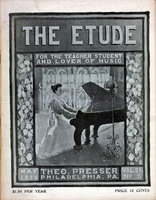Judging by the descriptions (?) of organs which one reads in the papers from time to time one would think that it must be an art to write a comprehensive description of a new organ. If one were describing a painting and confined the description to the amount of canvas and how long it took the carpenter to make the frame for the canvas, the would-be describer would not appear any more ludicrous than many of those who “report” our new organs.
The following description (?) of the new organ in Symphony Hall, Boston, which appeared in a well-known musical magazine soon after its completion, shows to what extent one can wander away from the required information in giving descriptions of things about which the writer evidently knows nothing:
Twenty-seven miles of electric wire and thirty-four hundred and ninety-two pipes are used in the make up of the great organ in Symphony Hall, and the instrument is played from a movable console or keyboard. This console looks a little like an upright piano, and by its use the organist may sit directly, under the conductor at the side of the platform, or, if he chooses, down on the floor in the midst of the audience; for the console is connected with the organ itself by a hundred feet of flexible cable containing three hundred and seventy-two wires.
Fifty-six stops sound the changes of the great and dignified instrument, and the pipes range in size from a big thing of thirty-two feet, weighing half a ton, down to a tiny reed three-quarters of an inch long and as thick as a lead-pencil. The sound of the big pipe is such an extremely low bass that to the hearer it would not seem to be a musical tone at all. It is more like the whirr of a powerful dynamo, causing a buzzing in the ears and a perceptible trembling of the entire hall and everything in it. The tone has its value, however, and is known as CCCC to the organ experts, but it is chiefly used to reinforce and give body and richness to the higher tones, with which it will be used simultaneously. As the aperture through which the wind passes into this monster pipe is only a half-inch crack, one may imagine what power there must be behind the air to produce such a result through so small an inlet.
The wind, without the assistance of which all the genius of the organist would avail nothing, comes up through big zinc pipes resembling those that usually carry the hot air from a furnace up through the house. The “wind room” is in the cellar, is about fifteen feet square, and is an air-tight apartment; for, notwithstanding the immense volume of air which the blower carries upstairs—two thousand cubic feet a minute—the only visible means for the admission of the air to the room is a crevice of less than two inches under the door. The organ-builder says that much of the air gets in through the walls, which are of cement and tile, and are constructed with the special object of being sound-proof, in order that the buzzing of the motor that runs the blower may not be heard in the hall above. But the blower is only designed for ordinary playing. When the organist wants “to raise the roof” with his half- ton pipes he touches a button that connects the motor to a series of huge bellows, which add a wind-pressure just double that of the blower.
Those who know all about organs say that the one in Symphony Hall combines all the dignity and majesty necessary for religious music, with an admirable flexibility and brilliancy for giving the lightest class of melodies.



